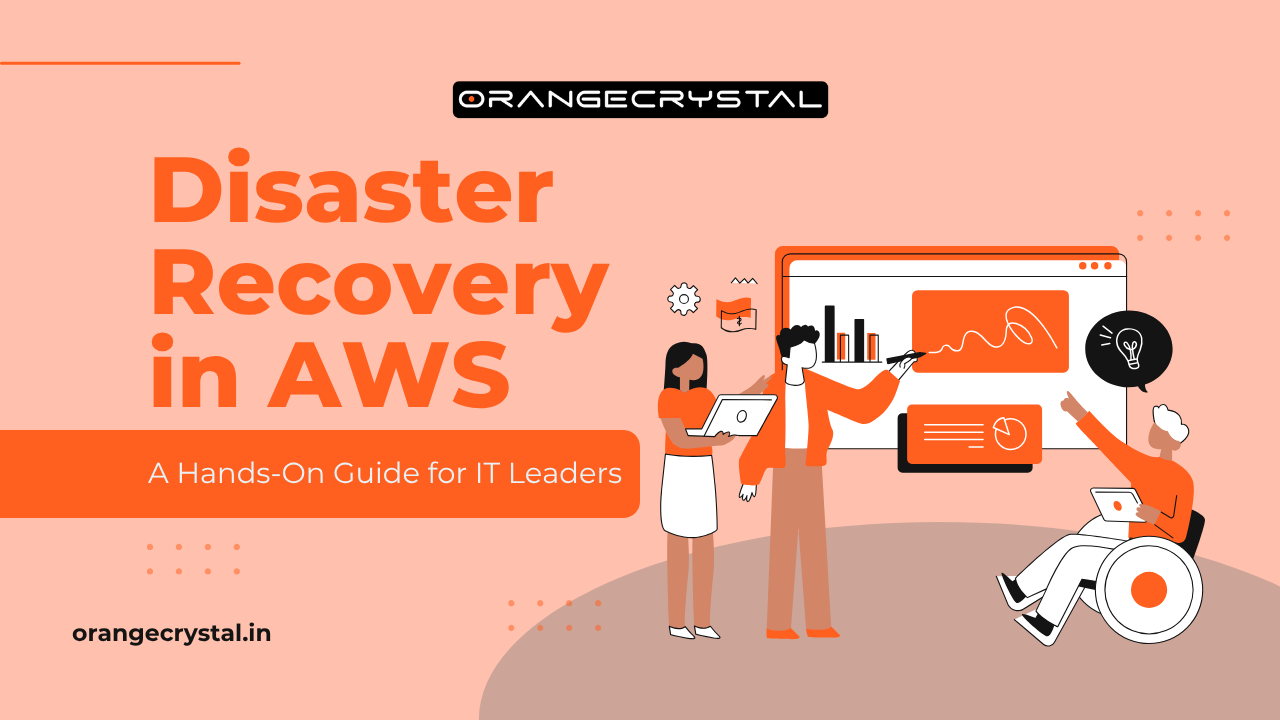Disaster Recovery in AWS: A Hands-On Guide for IT Leaders
Introduction: Why Disaster Recovery in AWS is Mission-Critical
In today’s always-on digital landscape, downtime is more than just a technical issue — it’s a business risk. Whether it’s an infrastructure failure, cyberattack, natural disaster, or human error, the cost of unexpected service disruption can be staggering.
For mid to large enterprises, Disaster Recovery (DR) is no longer optional; it’s a core component of operational resilience and regulatory compliance.
Enter Amazon Web Services (AWS) — a mature, globally distributed cloud platform that empowers IT leaders to build cost-effective, scalable, and highly automated disaster recovery strategies. This guide is specifically tailored for IT professionals who are looking to implement or refine DR strategies in the AWS ecosystem.
Understanding Disaster Recovery in the AWS Context
Disaster recovery refers to the processes and technologies that enable an organization to recover and continue operations after an unexpected outage.
In AWS, DR is not a one-size-fits-all solution; rather, it is a flexible set of architectural patterns and services that can be tailored to meet Recovery Time Objectives (RTOs) and Recovery Point Objectives (RPOs) based on business needs.
AWS provides a global infrastructure footprint, automated orchestration tools, and deep integration with security and monitoring services — making it uniquely well-suited for both cloud-native and hybrid DR scenarios.
Key AWS Services for Disaster Recovery
For a hands-on implementation, it’s critical to understand the AWS services that form the building blocks of a robust DR strategy:
- Amazon EC2 & AMIs: Backup and replicate virtual machines across regions or accounts using Amazon Machine Images.
- Amazon S3 and S3 Glacier: Ideal for versioned backups and archival of critical data with high durability.
- AWS Backup: Centralized backup service that automates and schedules backups across EC2, RDS, DynamoDB, EFS, and more.
- AWS Elastic Disaster Recovery (AWS DRS): Enables quick failover and failback of on-premise or cloud workloads with minimal downtime.
- Amazon Route 53: Allows automated DNS failover to redirect traffic during outages.
- AWS CloudFormation / Terraform: Infrastructure-as-Code tools for reproducible and rapid DR environment provisioning.
- AWS Organizations & Control Tower: For managing DR environments in isolated, governed AWS accounts.
Common Disaster Recovery Strategies on AWS
AWS supports a spectrum of DR strategies based on RTO/RPO, budget, and complexity:
1. Backup and Restore
Suitable for non-critical systems with higher RTOs. Data is regularly backed up to S3 or Glacier, and restored manually in the event of failure.
2. Pilot Light
Core components such as databases are kept running in a secondary region at minimal cost. Full-scale environments can be spun up quickly during a disaster.
3. Warm Standby
A scaled-down version of the production environment runs continuously in another region. In the event of a failure, traffic is rerouted, and instances are scaled up.
4. Multi-Site Active-Active
Applications run simultaneously in multiple regions with data replication. Offers the lowest RTO/RPO but comes with increased cost and operational complexity.
Each of these strategies can be customized using automation scripts, CI/CD pipelines, and observability tools to ensure seamless recovery and minimal business disruption.
Real-World Integration Scenarios
- Hybrid Environments: Enterprises often run workloads both on-premises and in AWS. Services like AWS DRS, AWS Storage Gateway, and Direct Connect allow seamless replication of critical systems.
- SaaS and Multi-Cloud Architectures: AWS integrates well with third-party SaaS monitoring and DR tools, allowing for broader ecosystem resilience.
- DevOps Integration: With tools like AWS CodePipeline, Jenkins, and GitHub Actions, you can embed DR checks into your deployment processes.
Operational and Strategic Considerations
- Compliance and Governance: Industries like healthcare, finance, and government have strict data residency and business continuity requirements. AWS provides region-specific data handling capabilities and auditing tools like AWS CloudTrail.
- Cost vs. Risk Tradeoffs: Not all applications require millisecond-level failover. Prioritizing systems by business impact allows better resource allocation.
- Test Regularly: A DR plan that isn’t tested is just a theory. Use AWS CloudEndure or custom Lambda scripts to simulate failover and validate processes.
ROI and Business Value
Investing in AWS-based disaster recovery yields tangible returns:
- Reduced Downtime Costs: Fast failover minimizes revenue loss and customer churn.
- Operational Efficiency: Automation reduces manual intervention and human error.
- Scalability: DR environments can scale with business growth without significant upfront investment.
- Audit-Ready: Meet compliance standards more easily with automated logs, encryption, and monitoring.
Final Thoughts: Build Resilience, Not Just Redundancy
A modern disaster recovery plan is not about duplication; it’s about resilience. With AWS, you can design intelligent, scalable, and cost-effective recovery strategies that align with your business’s risk posture and operational goals.
For system administrators, this means fewer sleepless nights and better tooling. For technical managers, it provides the assurance of business continuity and strategic agility. And for IT leaders, it’s a clear path to greater ROI and digital resilience.
Ready to Strengthen Your Disaster Recovery Strategy?
Our AWS-certified experts at OrangeCrystal specialize in architecting tailored disaster recovery solutions for mid to large enterprises across sectors. Whether you’re modernizing legacy systems or optimizing your current DR posture, we’re here to help.
Contact us today for a personalized consultation and take the first step toward building a truly resilient cloud infrastructure.



Leave a Reply